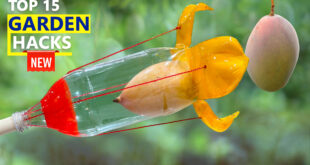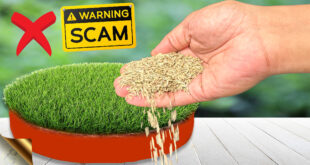Today’s post is a complete guide on Adenium or the Desert Rose plant, including Important Topics like it’s General Care tips, Nursery secrets of Growing Adeniums from Seeds, How to get the seeds, 5 Tricks to make the caudex grow thicker, How to save a dying Adenium or dealing with adenium rot, and lot more.
Adenium obesum, also known as desert rose, is a succulent plant with red, pink, white, and many varieties of flowers. Adenium is an extremely beautiful plant and sometime called Natural Bonsai, because of its thick stems and the modified fat lower stem called as Caudex.
Let’s Start with:
How to grow Adenium from Seeds: The most important criteria to grow from seeds – the Seeds must be fresh and healthy or from a reliable source. The ones you get online may be old and may not germinate. If you have one adenium and you take proper care of it, you should good flowering and then seed pod formation soon. It’s best to grow from fresh seeds or buy a plant from a nursery or even online. You can purchase adenium online because it’s a drought tolerant plant and easily survives without water even for 7 days.
Well, When you are growing adenium from seeds, you need to apply some tricks and hacks for successful germination.
First thing you need to do when you notice an adenium seed pod is tie some thread around the pod to prevent spillage of seeds before the seed pod matures and releases seeds. It has a special seed dispersal mechanism by wind, where each seed had this fluffy stuff which is easily carried away by wind. Here you can see, I have protected the seed pod from its natural dispersal mechanism. When the seed pod starts drying and cracks open, it’s the time to harvest the seeds. Separate the seeds by gently pulling this fluffy stuff……. So these are fresh adenium seeds we just harvested!
Now the first secret to get a great success rate in germination? These seeds are very delicate and are more prone to fungus. So what you need to do immediately is pour in some antifungal powder like bavistin or SAAF or any antifungal powder like Carbendazin + mancozeb combination. You can also add a mixture of cinnamon and turmeric powder if you don’t have antifungal. Coat the seeds with this antifungal powder whether you keep them aside for storage or plan to sow them immediately.
Now the next important step: The growing medium. You can use sand or some cocopeat mixed in it or soil plus sand plus cocopeat. If you have perlite, this is another great stuff. The idea is to have a loose well draining light weight soil mix for the seeds to sprout. You can mix small amount of anti fungal powder into this mix which combats the fungal rot.
Plant the seeds and cover with a thin layer of potting mix and do not plant too deep, they may not sprout. Then finally, you also mix some antifungal into the water or spray can and use the same solution to spray or gently sprinkle some water once every two days.
You can see they should start germinating within a week. On third or fourth week, you should see the beautiful tiny caudex of these babies. When they are about two months old, you repot these into independent containers. During transplant, you need to remember few important points during the process of repotting as well as post transplant care, like:
- Choosing clean containers or if using old containers, you can clean them using baking soda.
- Then comes the Potting mix: You can use any succulent potting mix. Or make your own using a simple recipe: like 50 percent sand, 40 percent Garden soil and 10% compost like cowdung or vermicompost. You can also mix perlite and other stuff if you have. You can find a detailed episode on succulent potting mix recipe from a link in description.
- Then comes Repotting: Have a look at the structure and the markings. The first mark is to demarcate the level above and below the soil. Make sure you insert the plant’s future caudex above the level of soil. If its too below the soil level, it can lead to rot and death.
- Then finally, water this once preferably mixing some antifungal in water and leave it in indirect sunlight for the first week. Water them occasionally like once a week or so depending on the climate.
General Care Tips for Growing Adeniums:
- SOIL: This is the most important factor for successfully growing adenium. It’s a desert rose and hence prefers a sandy soil. Make sure you have at least 50 percent sand or perlite mixed in your potting soil. You can check my detailed episode on making the best succulent potting mix recipe from a link in description.
- WATERING: If your soil is really well draining, the frequency of watering does not matter much, like for instance if you have lot of rains in your zone, its almost like daily watering. And also make sure, you have good drainage holes in your container. Otherwise, generally watering weekly twice or even once is the general rule for adenium like any other succulent depending on the climate of the zone you live in.
- SUNLIGHT: This is a very important factor for proper flowering. Adenium needs maximum sunlight and good humidity for flowering and growth. Atleast 6 hours of direct sunlight is a must! Also encourage pollinator insects like honey bees and butterflies to encourage seed pod formation.
- FERTILIZERS: Most recommend chemical fertilizers like water soluble NPK, but I always use organic ones like simple decomposed cowdung or vermicompost like a handful of it once a month. And during repotting mixing a table spoon of steamed bone meal or Organic rock phosphate for vegans. This much is sufficient to make the roots stronger and induce enormous flowering in all seasons except in it dormant season – that’s winter.
- PEST CONTROL: Its commonly affected by sucking pests like aphids, mealy bugs and mites. Weekly spray of 5 to 10 ml neem oil in 1 litre of water will easily control this problem.
5 Tricks to make caudex grow thicker:
Some Adeniums develop a thicker caudex themselves, perhaps determined by the genetic characteristics of the plant, but others may require human interventions. Apply these 5 Tricks and hacks to make the adenium caudex powerful and thicker.
- POT SIZE & SHAPE SELECTION: Select a pot that is wider than deep. This forces the root system to become exposed to air as it grows and we call it Training your Adenium or Adenium Bonsai Training or adenium root training. Depending on the size of your plant, take a wider container, roughly about 2-3 inches extra space around the existing caudex. And the depth of the pot of about 4 to 6 inches should be fine.
- WATERING TRICK – ONLY water it when it’s starving and very thirsty. That is when your soil is fully dry like using the finger dip method. 1 OR 2 INCH inches of your finger. And whenever you water it GIVE FULL WATERING. This frequency depends on the climate. Like in summer, the frequency increases where as in winter, this can be weekly once. Make sure the soil is well draining as discussed already.
- CUTTING THE CENTRAL ROOT – the tap root of adenium. The caudex is actually the storage organ of adenium – This is an adaptation from mainly the stem and also partly the root. This cutting helps to make the caudex wider and thicker. But perform this step at your own risk very carefully, because there is a risk of rot and death of the plant. Before carrying out cutting, try to wash or spray the root with Hydrogen peroxide solution, about 1 teaspoon in 1 liter or water. Or first wash the dirt in running water and then spray some h2o2 solution on the roots. Make sure when you perform cutting, disinfect the cutting tool with a hydrogen peroxide solution or any disinfectant. You can cut it carefully without cutting or damaging some side roots. After cutting apply a Fungicide powder like SAAF. SAAF is a brand name for combination fungicide with Carbendazim and Mancozeb. You leave this in air for 2 days to form a callous wound. Then you can repot by placing some flat object like a plastic lid below this root flat and then repot.
- PRUNING: PRUNING of branches helps to increase caudex. This is because most of the plant energy is diverted to growing thicker caudex rather than leaf and flower development. You can leave few branches or leaves for photosynthesis. The pruning will not only increase caudex size, but also increase branching and flowering. Remember to seal the cut end with candle wax or a fungicide powder to protect your plant from rot. If it’s a grafted adenium, you should always cut above the graft. IF its seed grown plant, you can hard prune or cut at the level of caudex, so that more branches emerge out from the caudex itself. The best time to prune adeniums as recommended by many experts is after the spring or when temperatures are high. You can check my episode on some Important Pruning Tips and precautions from a link in description below.
- REPOTTING and RAISING THE CAUDEX to Half to One Inch, every 3 to 6 months. This trick will not only increase the caudex size but also give a beautiful bonsai look to the plant.
How to save a Dying Adenium or How to treat Adenium Rot:
There are two problems to diagnose. One is root rot which can lead to stem rot and death of the plant. The second problem to differentiate from the first one is soft caudex or soft stems which may or may not destroy the plant.
You can carefully look for Some signs of root rot or impending danger like:
a. Leaves becoming yellow and dropping,
b. Caudex pimples – like If you see some pimple like spots popping up on the caudez, this may indicate too much water inside the caudex and the plant is trying to creat exit pathways for this excess water.
c. Softening of the caudex or branches is another sign. Normally the caudex and branches are firm when you press with fingers. But if its getting soft, then there is a danger.
d. Inspect of any Injury. Generally injured stems or caudex can start to rot from the injury point. This is called Focal rot and is easy to treat when diagnosed in early stages.
Well, The Treatment steps vary depending on the signs and symptoms.
If it’s a focal rot, you need to cut off that portion using a clean knife and then apply antifungal powder over the wound and just leave it to heal and keep it in full sunlight. Do not pour water over this wound.
If the caudex is becoming soft, you can remove the plant and inspect its roots. Then soak this in a strong fungicide solution for few minutes and then hang it in air in sunlight for 2 to 4 days. It should start shrinking and possibly start healing. If its getting firm, then you can repot in a fresh potting soil and then water with antifungal mixed and leave it undisturbed for a week.
 GKVKs – Gardening Tips and Store Gardening Tips and Store
GKVKs – Gardening Tips and Store Gardening Tips and Store



